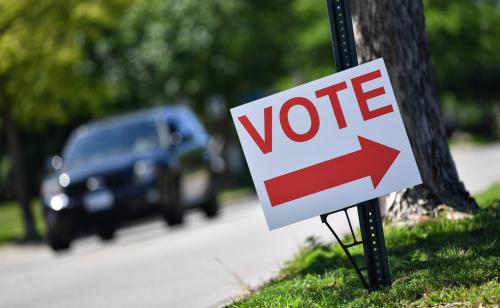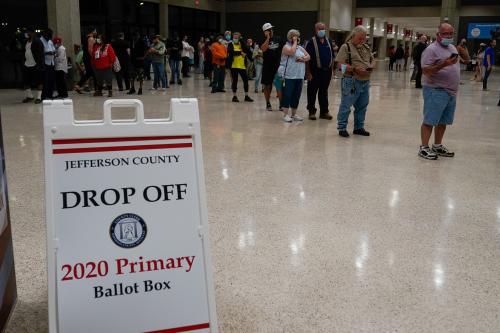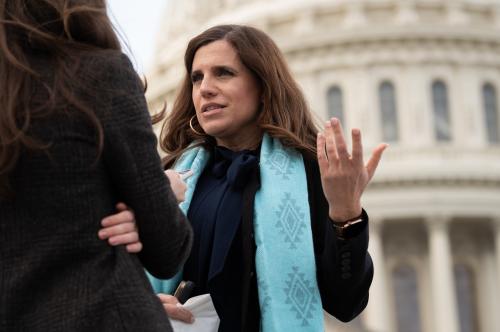So here we are, eight months before any votes are cast in the race for the Republican nomination and by most standards—polling, name recognition—Donald Trump is set to win it again.
So why are so many Republicans lining up to challenge the former president? Some of them are longshots with money to burn, but others are well-known elected officials with experience, money, and a reasonable story for why they should be president. Last week, Senator Tim Scott (R-SC) joined the race and soon we expect former New Jersey Governor Chris Christie to join along with former Vice President Mike Pence.
A few months ago, I helped create the now conventional wisdom which says that a large field of challengers will help Trump because the Republican winner-take-all or winner-take-most delegate selection rules are tailor made for a candidate who holds a solid base among primary voters and who can wrack up a series of plurality wins.
But the conventional wisdom overlooks an important caveat—for Trump to win, he has to win early, and the field of candidates has to be large and stay large after Super Tuesday 2024.
Here’s why.
The race for a presidential nomination takes place in three stages. We’re in stage one right now: the so-called “invisible primary.” This stage lasts from the spring of 2023 until the first votes are cast. During the invisible primary, a lot of important things happen. Candidates raise money, they build campaign staffs, they hone their appeals to the party faithful. And a lot of early conclusions are drawn–often incorrectly. Frequently, the candidate with widespread name identification is the “winner” of these early polls and goes on to win the nomination.1 By most measures, Trump is winning the invisible primary, which is good news for him.
However, he is not home free. Trump is not your ordinary front runner. He has been indicted and may face more indictments before the Republican convention next summer. He has doggedly stuck to cultivating his base, which, while intense and loyal, is not likely to carry him in a general election. While he is loved, he is also hated, meaning that he will certainly have problems in the general election.
So, onto stage two of the process—the early primaries. This stage runs from late January or early February 2024 to March 4, 2024, or whenever the day before the Super Tuesday is. In 2024, the early primary stage will (on the Republican side) consist of four states: Iowa, New Hampshire, Nevada, and South Carolina. These four small states have very few delegates. In fact, out of the approximately 1,234 delegates, someone will need to win the Republican nomination, these states in total only account for 138 delegates or just 11% of the total needed to win.2
During this short period of time, perhaps only five or six weeks, Trump will be most at risk. In these weeks someone needs to take the nomination away from him. This could happen if he performs below expectations. Many a frontrunner has stumbled in these states. As far back as 1968, President Lyndon Johnson won the New Hampshire primary with 48% of the vote but Sen. Gene McCarthy (D-MN) won a sizeable enough percentage of the vote (42%) that a few weeks later, Johnson decided not to run again. More recently, Hillary Clinton’s supposed juggernaut to the nomination was upset by a young African American senator from Illinois, Barack Obama, whose surprising win in the nearly all-white Iowa Caucuses of 2008 turned the nomination into a long race which Clinton ultimately lost. In these early contests, someone can catch fire, and when they do, they acquire that most valuable of presidential primary assets: momentum. But if Trump wins in the early contests, a few candidates may stick around to split up the anti-Trump vote, as happened in 2016, and that will help him win.
That brings us to stage three of the nominating process. What makes stage three so critical is that it is a three-month race for delegates and one in which candidates have to be able to compete in 46 states with different types of systems. Momentum is worth more than money as billionaires Tom Steyer and Mike Bloomberg discovered in 2020. Stage three begins in the first week of March and continues on until the first or second week of June. During this period, candidates will trade the retail campaigning of the early states to participate in a mad dash around the country from TV studios and radio stations. If someone other than Trump catches fire, they will amass large sums of money thanks to internet fundraising and the kind of free press—momentum—that is manna from heaven for a campaign. If stage three features a one-on-one race between Trump and some new fresh face, Trump could very well lose the delegate race.
This requires, however, that the candidates that falter in the early states get out of the race. In 2016, that didn’t happen. The current conventional wisdom that says a large field helps Trump is based on a scenario where all candidates stay in the race, thus allowing Trump to be a plurality winner. However, some Republicans are harkening back not to 2016 but to the 2020 Democratic race where, in a fast-paced weekend between the South Carolina primary and Super Tuesday, most of Biden’s opponents dropped out of the race, allowing him a one-on-one contest with Bernie Sanders, which he won handily.
If Trump falters in stage two and finds himself facing one strong opponent, he could be defeated in stage three. In spite of his strong showings in polls of Republican voters, a recent CNN poll found that “…wide swaths of Republican-aligned voters are willing to consider either of the two, [Trump or DeSantis] as well as several other candidates.” A recent Washington Post poll found that Republican voters were not very focused on electability, which would seem to favor Trump. However, “electability” matters in primary elections and many a voter has voted their head over their heart in order to beat the other party. It was the electability issue which catapulted Biden from “dead man walking” to Democratic nominee in just 72 hours in March of 2023.
So, while the safe bet right now is on Trump—what happens in the early primaries will determine whether his path to the nomination will be straightforward or not. In June of 2015, the Republican frontrunner was Florida Governor Jeb Bush, and look what happened to him—he did poorly in the first three contests and never even made it to Super Tuesday.
-
Footnotes
- For more information see Party Animal: The Front-Runner in the Presidential Invisible Primary.
- Estimates of total delegates are early but not likely to change the overall percentage.
The Brookings Institution is committed to quality, independence, and impact.
We are supported by a diverse array of funders. In line with our values and policies, each Brookings publication represents the sole views of its author(s).








Commentary
The only way Trump can lose the Republican nomination
June 2, 2023